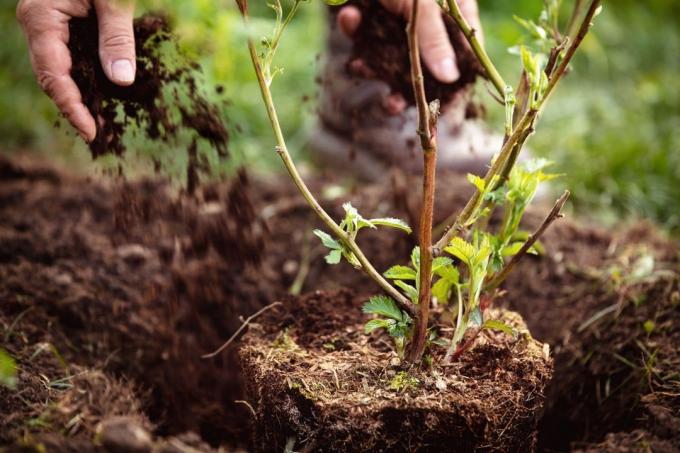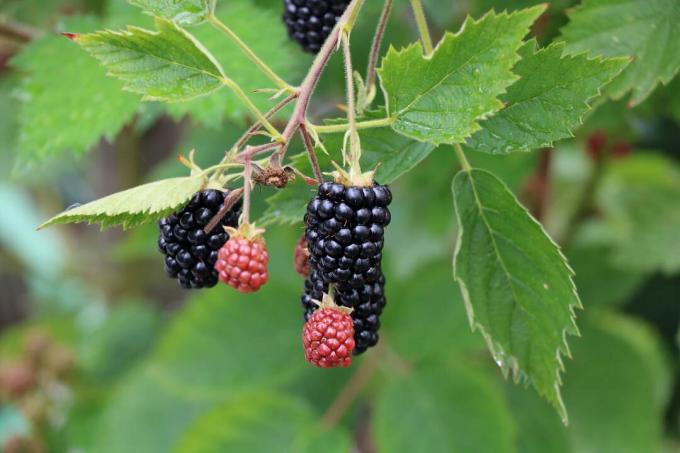
Table of Contents
- Radical cut recommended
- Best time
- Identify old rods
- Radical Cut: Instructions
- Radical pruning when transplanting
- frequently asked Questions
Blackberries are among the oldest types of fruit in Central Europe. On a sunny site, the harvest of large berries will be plentiful. To keep it that way, you should radically cut back all worn-out canes of the blackberries. Here's how to do it.
In a nutshell
- Blackberries grow fast and strong
- Radical pruning in spring
- worn rods provide protection in winter
- only leave four to seven new young shoots
- Cut back worn rods radically close to the ground
Radical cut recommended
Blackberries (Rubus sect. Rubus) have a very strong growth. They can reach a height of between 50 and 400 cm. Therefore, regular pruning is necessary in order not to get an impenetrable hedge in the shortest possible time. The wood can be cut radically. It then drives out again very quickly from the basal buds and also from the roots. A radical cut of the blackberries has the following advantages:
- Bramble keeps its shape
- serves to maintain health
- no rooting of long shoots
- timely removal of disease-prone shoots possible
- ensures good harvest and big berries

Tip: Since blackberries have a strong tendency to proliferate, a rhizome barrier should be installed when planting. Pond liner at a depth of 30 cm is suitable for this, since blackberries have relatively shallow roots.
Best time
With blackberries, it is necessary to radically remove all worn-out old shoots. In mild regions, this can already happen after the harvest in September/October. However, it is better if these rods remain on the wood over the winter. They offer the young shoots sufficient protection from cold, frost and winter sun. However, a radical pruning is then necessary in early spring, by March at the latest.
Identify old rods
Worn, old canes can be distinguished relatively well from viable young shoots in spring. Old shoots older than a year will no longer bear fruit. They are mostly heavily woody and brown in color. Young shoots, on the other hand, are
- nice light green
- very smooth and
- hardly lignified.

Notice: A blackberry only produces fruit on one-year-old wood, i.e. shoots that grew in the previous year.
Radical Cut: Instructions
With such a pruning in spring, there are a few things to consider so that a good harvest can still take place in the same year. First of all, it is important to have the right tool:
- sharp Rose Scissors
- disinfect with alcohol before and after use
- Gloves for your own protection
After some preparation, the blackberries can then be cut back radically. The procedure is as follows:
- Separate old and new annual shoots
- radically remove worn-out old shoots close to the ground
- select four to seven strong new shoots
- normally four shoots are sufficient for a rich harvest
- Also remove the remaining shoots close to the ground
- remaining shoots on trellis or wire frame untie upwards
- Shorten existing side shoots on young canes to two or three eyes
- all standing too close, frozen, dead and suffer Remove rods at base
On the new shoots, the fruit wood is formed on the remaining buds in the following spring. The flowers appear first and then the berries in August to September. The resulting plant cuttings can simply be shredded and then disposed of in the compost. Of course, diseased shoots are excluded. These go in the trash.

Tip: The fewer fruit shoots left on the tree, the better the fruit setting and quality of the berries. With many side shoots only small berries are formed.
Radical pruning when transplanting
Extreme pruning is also necessary when the tree is transplanted again, especially if only parts of the root are transplanted. This radical pruning of the blackberries means that the root can still fully support the plant. If no pruning takes place, the rootstock would no longer be able to sufficiently supply the remaining and unabridged shoots with water and nutrients. The transplanting and also the radical pruning should be done before April. The blackberry is then still able to sprout well and produce enough fruit. In this way, a rich harvest can take place in the same year.
frequently asked Questions
In the wild they grow as hedges in sunny forest clearings and ruderal areas. They also prefer a sunny spot in the garden. Here they set many flowers and the intensive visit of insects ensures high fertilization. The soil should be well drained, rich in humus, not too light and calcareous. A pH between 5.5 and 6.5 is ideal.
In the spring, more precisely in March, a nutrient dose is to be administered. To do this, two liters of mature compost are applied to one square meter. In poorer soils, an admixture of organic berry fertilizer is required. This one fertilization is perfectly sufficient. Fertilization should be stopped from July. Blackberries do not tolerate drought well. The soil must never dry out completely. This is the only way to harvest large berries. It is also advisable to mulch the soil.
However, spring from May is optimal. Planting is done on trellises or tension wires. They are set at least three finger widths lower than in the container. This promotes the formation of new canes. All existing rods are shortened to 30 cm after planting. This is followed by thorough watering and a light layer of mulch, such as dried grass clippings, is applied.


